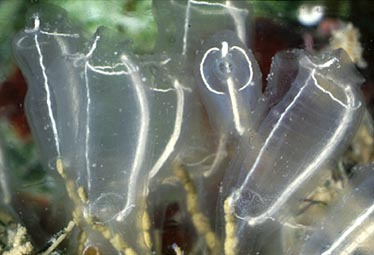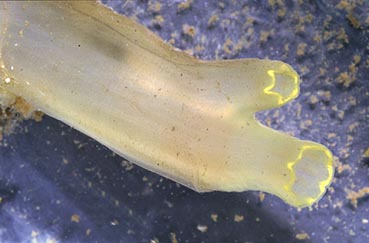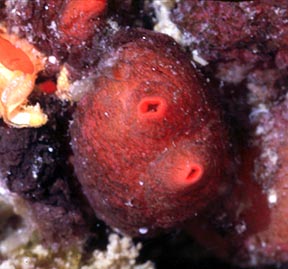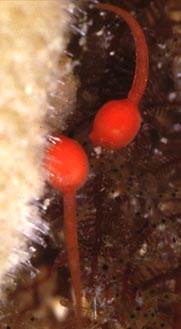SEA SQUIRTS our distant cousins |
by Jan Parmentier
and Wim van Egmond

Clavelina, a group of transparent sea squirts
by Jan Parmentier and Wim van Egmond |
Clavelina, a group of transparent sea squirts |
 Ciona, the same genus as the egg on page 1, showing the two siphons |
Sea squirts or Ascidians, which is their
Latin name, belong to the subphylum of the Tunicata. The tunicates are favored as vertebrate ancestors in the long past. Nothing can be seen of a vertebrate relationship in the adult animals, but the tadpole larva has a so called notochord, a stiff rod in its tail. This tail can be thought as ancestral to rings of cartilage or bone (vertebrae). It is because of the imagined evolutionary position as vertebrate ancestors, that these interesting small animals have excited such a wide interest. Tunicates are very interesting small marine animals. The sessile forms (Ascidians) are easily found on almost every marine solid surface: rocks, jetties, algae. |
| Tunicates are so named because the outer
layer of the body wall is a tough "tunic", made
of a substance that is almost identical with cellulose.
In essence the animal consists of a double sac with two
siphons. Sea water is pumped slowly through one siphon,
sieved through the inner sac for plankton and organic
detritus , and the filtered seawater is pumped out again
through the second siphon, the atrium. The pumping is
caused by cilia. The current through the atrium is faster
than the incoming one, to avoid mixing of the two
currents. The atrium also serves as an exit for faeces
and sex cells. Ascidian Tunicates are called sea squirts because when taken out of the water they squirt the water inside their body with force through the atrium. |
 Stolonica socialis, photographed in Brittany, France |
There is an open blood system with a
tubular heart, which lies below the digestive loop. The
animal has a simple nervous system. The outer sac, the test, can be leathery or translucent, or the gelatinous or viscous matrix of a colonial, compound form. The test is often brightly colored. |
 Two tadpole larvae of Stolonica socialis |
Click here to find Botryllus, a beautiful colonial tunicate |
| The size of the animals mostly ranges
from a few millimeters to several centimeters, in N.W.
Europe at most 15 cm. Most Ascidian families are
cosmopolitan. In essence they are one year organisms,
developing the first year, then breeding and dying the
following year. Ascidians are hermaphroditic. Most large solitary species shed high numbers of weakly yolked eggs into the sea, coincidentally with the release of sperm from other individuals. External fertilization is followed by the development of a free swimming tadpole larva, rarely more than 5mm long. However, there is a great deal of variation in the reproductive strategies of tunicates. Colonial species, like Botryllus, and many small solitary ones have few eggs and incubate their embryos in their body, near the atrium. It is not too difficult to see something of the biology of these animals. They are easy to collect on every rocky shore or on wooden poles or jetties. The tadpole larvae are often present in plankton catches. |
| Further reading: J.Alder, A Hancock, The British Tunicata, 3 volumes, 1904, 1906, 1911, Ray Society N.J.Berrill, The Tunicata, 1950, Ray Society P.J.Hayward, J.S. Ryland, The Marine Fauna of the British Isles and North-West Europe Vol 2, Oxford Science Publications 1990 |
The pictures on this page were made by Jan Parmentier. Comments to the authors Jan Parmentier and Comments to the author sent via our contacts page quoting page url plus : ('wegmond','')">Wim van Egmond are welcomed. © Jan Parmentier and Wim van Egmond 1998
Microscopy UK Front Page
|